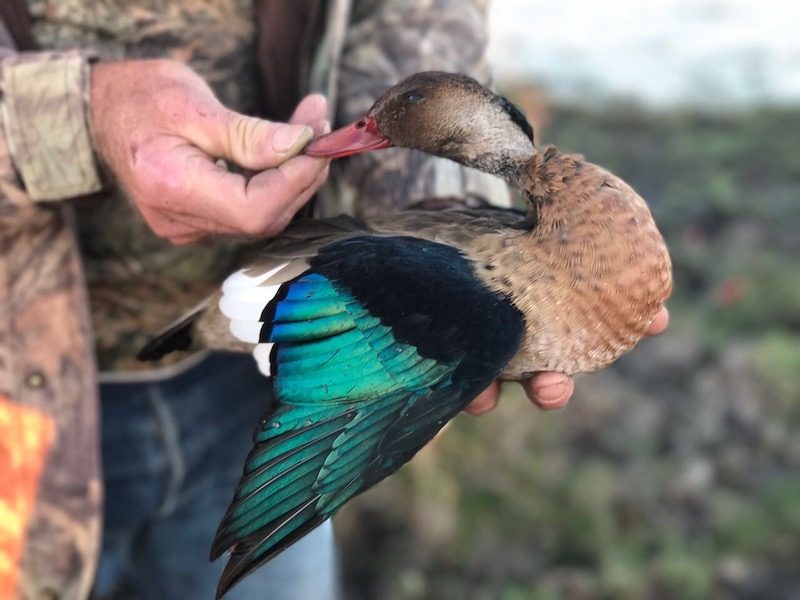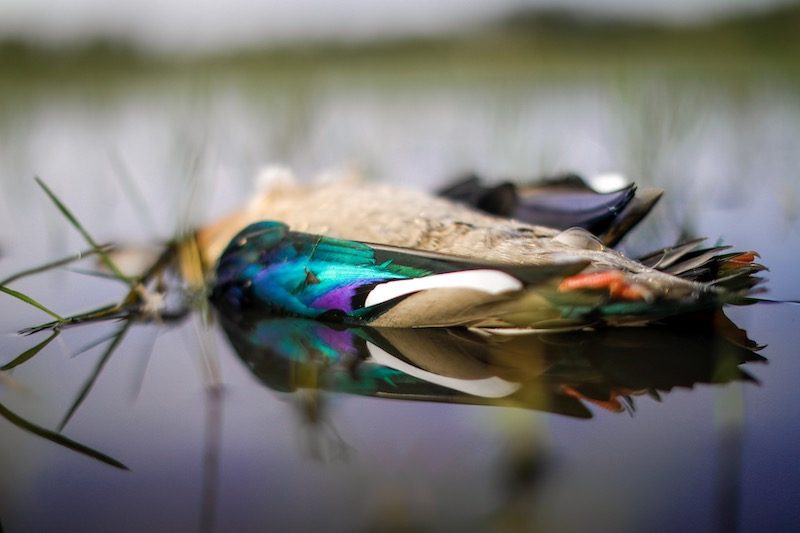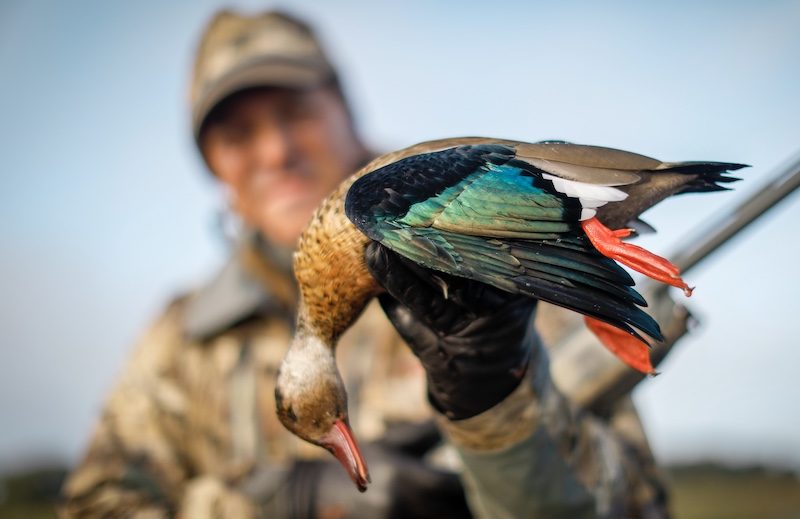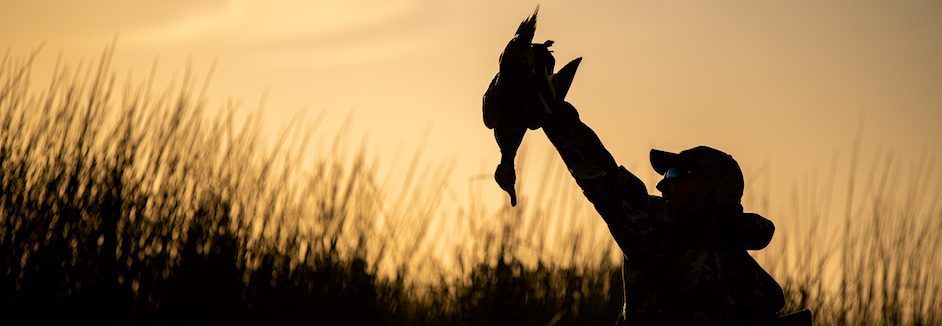Brazilian Duck (Teal)
 Brazilian Duck (Amazonetta brasiliensis), also known as the Brazilian Teal, is a small duck that is the only member of the Amazonetta genus. When at rest, this species looks fairly drab with mostly chestnut body plumage. Males are differentiated from females by their red bill and bright orange legs and feet. Female Brazilian Ducks display gray bills with similar legs and feet to the males. Males have rusty plumage directly behind their bull that extends to their crown. Females have white “eyebrow” patches and a gray crown. With extended wings, Brazilian Ducks show intricate iridescent plumage. On their lesser and median coverts, males have black feathers that seem tinted with purple. The rest of the wing is spectacular, with iridescent teal and dark blue, in addition to the stark white tips of the secondaries that are prominently visible during flight, a tell-tale indicator. Females have similar wings but their primaries are gray.
Brazilian Duck (Amazonetta brasiliensis), also known as the Brazilian Teal, is a small duck that is the only member of the Amazonetta genus. When at rest, this species looks fairly drab with mostly chestnut body plumage. Males are differentiated from females by their red bill and bright orange legs and feet. Female Brazilian Ducks display gray bills with similar legs and feet to the males. Males have rusty plumage directly behind their bull that extends to their crown. Females have white “eyebrow” patches and a gray crown. With extended wings, Brazilian Ducks show intricate iridescent plumage. On their lesser and median coverts, males have black feathers that seem tinted with purple. The rest of the wing is spectacular, with iridescent teal and dark blue, in addition to the stark white tips of the secondaries that are prominently visible during flight, a tell-tale indicator. Females have similar wings but their primaries are gray.
Brazilian Duck has a considerably large range that extends from Uruguay, Argentina, Paraguay, Venezuela, Brazil, Peru, Suriname, Guyana, French Guiana, Bolivia, and to Columbia. There are two recognized subspecies of Brazilian Teal—the Lesser Brazilian Teal and the Greater Brazilian Teal. The  Lesser inhabits Brazil, Suriname. Guyana, French Guiana, Venezuela, Columbia, and Peru; while the Greater inhabits Brazil, Argentina, Bolivia, Uruguay, and Paraguay. Brazilian Duck take advantage of areas with access to freshwater that is not near coastal waters. While they have been known to make use of somewhat saline waters, they prefer lakes, ponds, rivers, and marshy areas that have dense vegetation.
Lesser inhabits Brazil, Suriname. Guyana, French Guiana, Venezuela, Columbia, and Peru; while the Greater inhabits Brazil, Argentina, Bolivia, Uruguay, and Paraguay. Brazilian Duck take advantage of areas with access to freshwater that is not near coastal waters. While they have been known to make use of somewhat saline waters, they prefer lakes, ponds, rivers, and marshy areas that have dense vegetation.
Brazilian Teal in Paraguay begin their breeding season in November until December. In Argentina, the breeding season is from June to July. This is not a very social bird as they are rarely seen in groups of more than twenty birds. Brazilian Duck are also commonly seen in pairs. Females will lay six to twelve pale yellow eggs. Both parents take part in rearing the young, which only consume insects. Adult Brazilian Ducks will forage for seeds, fruits, and insects.
Available Hunts
-
Argentina Duck Hunt – Parana River Delta
An Argentina duck hunt destined to become absolute legend, the Parana River Argentina duck hunting an immersive adventure in one of the wildest places ever.
...read more- Wildest, most remote duck hunt in Argentina, pure adventure
- Luxury liveaboard accommodations, < 15 minutes from duck blind
- Amazing gourmet meals, excellent wine selection (an Argentina wine tasting offered each week)
- Located about 4-5 hours travel from downtown BA, last 1.5 hours by boat
- Rosy-billed pochards, white-cheeked pintails and teal predominate the bag
- Choose high-volume ducks twice daily, or afternoon golden dorado fishing
Rate: $975 -
Argentina Duck Hunt La Paz
La Paz Argentina Duck hunting combo is true, high-quality trigger-pulling vacation for ducks, doves, perdiz, pigeons, fishing, more.
...read moreArgentina duck hunting La Paz combo package features duck hunts combined with high-volume dove hunting, world-class perdiz hunting, decoying pigeon, golden dorado fishing. Great value, a real client favorite.
- Customizable itinerary for ducks, doves, pigeons, perdiz, fishing
- Nearby non-hunting activities, fun for spouses and entire family
- Excellent chef-prepared meals, unrivaled hospitality
- Private suite lodging, casual family atmosphere
- Personal concierge services entire trip
- As featured on MOJO TV
Rate: $3,950 inclusive 3-day package -
Argentina Duck Hunting Las Flores
High-volume Argentina duck hunting is a "real duck hunter's duck hunt" that consistently produces over-the-top action. You've tried the rest, now come try the very best!
...read moreArgentina duck hunting Las Flores is our poster-boy Argentina duck hunt. For over a decade, this operator consistently delivers generous duck limits without fail. Convenient hunt that all duck hunters will enjoy.
- Fun, fast-paced duck hunts, generous limits every single day without excuses
- Tons decoying rosy-bills, all Argentina species available
- Located 5.5 hours from EZE, < 30 minutes to blinds
- Great lodging, superior meals, best-stocked bar in Argentina
- As featured MOJO TV; Wildfowl, Predator Nation, Peterson’s and Trigger, Field & Stream, more
Rate: $1,150 -
Argentina Duck Hunting Los Ceibos Combo
Excellent Argentina duck hunting combo program, fully customizable to include doves and perdiz and is conveniently located within few hours easy drive time.
...read moreArgentina Duck Hunting Los Ceibos Combo is perfect for clients with limited mobility or that do not want to pack lots of gear. Daily morning duck hunts, hunters choice of perdiz or doves during afternoons.
- Fully customizable shooting program – choose any daily combination of ducks, doves, perdiz
- Located within easy hours very easy drive on International Highway 14 from EZE
- Several authentic estancias, hunting never more than 20 minutes away
- Never mixed with other groups, regardless of party size!
- Excellent bilingual host entire trip
- Nearby non-hunting activities
Rate: $850 -
Argentina Duck Hunting Rio Salado
High-volume Argentina duck hunting a remote wetland that's well worth the effort.
...read moreArgentina duck hunting Rio Salado for die-hard duck hunters that will go the distance for high-volume shooting, high species diversity, and unspoiled habitat. Welcome to real Argentina.
- NO LONGER BOOKING THIS HUNT!
- Remote 74,000-acre wetland
- 1 hunter per blind unless requested
- Pure duck hunting
- Bilingual hosting for the entire trip
- Featured MOJO TV, Outdoor Life, Wildfowl, Sports Afield
Rate: N/A
Brazilian Ducks, or Brazilian Teal, are usually low-flying, two white wing spots popping intermittently, contrasting murky swamp. Maybe you find yourself tracking little bouncing white balls early, when it’s so dim that dragon breath leaps from the barrel at the shot. But later, in sparkling sunlight, it’s like swinging through a pair of fist-sized emeralds tossed across home plate. A favorite of northern Argentina hunters, Brazilian Duck’s iridescent wings flash in the morning sun. Dark heads and red lips (i know, they’re called bills) indicate drakes.




















